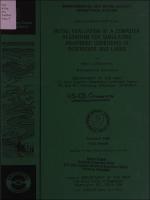Please use this identifier to cite or link to this item:
https://hdl.handle.net/11681/3015Full metadata record
| DC Field | Value | Language |
|---|---|---|
| dc.contributor | Environmental and Water Quality Operational Studies (U.S.) | - |
| dc.contributor.author | Zimmerman, Marc James, 1947- | - |
| dc.date.accessioned | 2016-03-15T20:26:54Z | - |
| dc.date.available | 2016-03-15T20:26:54Z | - |
| dc.date.issued | 1986-02 | - |
| dc.identifier.uri | http://hdl.handle.net/11681/3015 | - |
| dc.description | Miscellaneous Paper | - |
| dc.description | Abstract: Anaerobic biogeochemical processes can lead to the generation of undesirable concentrations of dissolved metals and nutrients in reservoirs and lakes. This report evaluates a series of computer algorithms developed to predict the concentrations of these materials in proposed and existing reservoirs. The algorithms, in the format of 13 subroutines, are incorporated in CE-QUAL-R1, the Corps of Engineers' one-dimensional, numerical model of reservoir water quality. This evaluation documents procedures used early in the development and testing of the algorithms and has since led to modifications which have already improved CE-QUAL-R1 simulations in other applications. Field data derived from studies of DeGray Lake, Ark., provide the basis for calibrating and evaluating the algorithms. New model features specifically related to the simulation of anaerobic water quality conditions include a simplified approach to relevant aquatic chemistry, a dissolved oxygen threshold concentration to initiate anaerobic processes, and simultaneous release from sediments of reduced materials and dissolved phosphorus. Oxidation and reduction processes in the water column are subject to the same constraints as those affecting sediment release. Two years of data from field studies, 1979 and 1980, were used to calibrate and evaluate simulations. In calibrating the model for assessing the new algorithms, sediment release rates were found to affect predictions most significantly. Although there were some discrepancies between observed and predicted conditions, trends and peak concentrations generally matched well. Further studies and applications of the model should help to assess its value as a tool in reservoir water quality management. | - |
| dc.publisher | Environmental Laboratory (U.S.) | - |
| dc.publisher | Engineer Research and Development Center (U.S.) | - |
| dc.relation | http://acwc.sdp.sirsi.net/client/en_US/search/asset/1040505 | - |
| dc.rights | Approved for public release; distribution is unlimited. | - |
| dc.source | This Digital Resource was created from scans of the Print Resource | - |
| dc.subject | Anaerobic conditions | - |
| dc.subject | Nutrients | - |
| dc.subject | Dissolved oxygen | - |
| dc.subject | Reservoirs | - |
| dc.subject | Lakes | - |
| dc.subject | Water quality models | - |
| dc.subject | CE-QUAL-R1 | - |
| dc.subject | Computer programs | - |
| dc.subject | Mathematical models | - |
| dc.subject | Numerical models | - |
| dc.title | Initial evaluation of a computer algorithm for simulating anaerobic conditions in reservoirs and lakes | - |
| dc.type | Report | en_US |
| Appears in Collections: | Miscellaneous Paper | |
Files in This Item:
| File | Description | Size | Format | |
|---|---|---|---|---|
| MP-E-86-1.pdf | 12.77 MB | Adobe PDF |  View/Open |